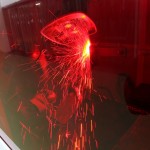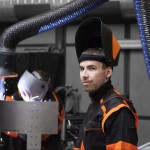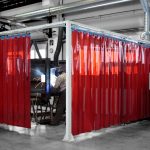Air recirculation during welding: Yes – see conditions
Air circulat solutions are becoming increasingly more important in planning extraction systems and filter technology in operations. They promise lower energy costs. But a recirculation of filtered air is not suitable in all cases – in some cases it is even prohibited.
Falling energy costs, that initially sounds good for many companies when planning extraction and filtration systems to protect of their employees – ensure occupational safety and also keep costs in check. And indeed: Especially in the winter months, air recirculation can represent a huge potential for cost saving. The idea behind it is simple: Dangerous welding fume particles are filtered in the system from the overall recovered air. While the hazardous substances remain in the system isolated from the air , the cleaned air re-enters the hall area.
Extraction and filter systems enable air recirculation
As the already warmed air can now be reused, there is no need for additional warming of new air from outside, so the opposite effect of an exhaust air system, where the dirty is expelled from the hall. Today there is this option for stationary equipment or filter towers, which may be mobile. But the regulations for this are not the same in all countries. In France, for example, there would not even be a discussion about an air recirculation system. There, all air collected by extraction units containing welding fumes, must be expelled. National regulations dictate how air circulation can take place.
The pre-supposition before even considering air recirculation is that the air is sufficiently scrubbed of dangerous welding fume particles. The focus here being on ultra-fine dust particles that are smaller than 0,1 µm. The fact is that today, modern extraction and filter systems are capable of extracting welding fumes and scrubbing the air to such a degree that it can be safely directed back into the production hall. However, there are limitations to this, too.
Use of highest class of welding fume elimination is recommended
Especially areas where materials that are most hazardous to welders when being finished cannot be fitted with air recirculation, not is it permitted to do so. These include hazardous substances such as those generated when working with chrome-containing and nickelous materials, precisely those which are carcinogenic, genetic-altering or even reprotoxic. If uncleaned and then filtered air is to be recirculated with such hazardous substances, filters of the highest available class of welding fume elimination is top priority. Nowadays such filters having an elimination efficiency level of over 99% against welding fumes. By employing these types of filters, metal-working operations also can be assured of filtering out the ultra-fine particles from the air. Because the new filter systems also remove these to a large extent.
For hazardous materials that are not on the list of materials with the highest risk potential, effective extraction and filter systems are also necessary. It depends greatly on the alloy proportion of the used materials and the risk potential that they hold. The degree to which they are categorised is determined by national legislation, however. Many companies go for the safest option and fit the most powerful filter when selecting law-complying welding fume elimination class filters.





